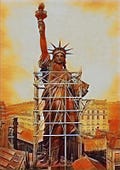1776 Did the American Revolution Give Birth to Twins?
In 1776 two American ideologies were born | Topics #RebalancePartySystem and #Insurrection
Core values topics - #RebalancePartySystem and #Insurrection
Indeed, the challenge of convincing a large segment of the population that education and science are not adversaries has persisted for a significant period, dating back to at least 1861. It's a recurring conversation that reflects deeply rooted beliefs and ideologies.
Often, our responses to events are influenced by our political affiliations and perspectives. It's important to acknowledge that two political parties naturally have differing platforms and beliefs; otherwise, we might have a single party with extreme views.
The imperative now is to focus on educating the next generation about history and cultivate an audience that is receptive to social transformation. While we cannot change the decisions made in the past, we can be accountable for ensuring an accurate portrayal of American history.
Becoming the custodians of the past, with all its complexities and nuances, is essential. The answers to our differences can often be found in understanding the historical context and evolution of our society.
Two American ideologies were born on July 4, 1776.
We have a historical and ideological divide that runs deep in America. These two opposing ideologies, born at the nation's inception, have evolved in disparate directions, shaped by distinct cultures, geographies, and core values. The Patriots and Loyalists, who fought for and against Independence, respectively, represent this profound historical schism.
Today, we continue to witness a stark contrast in perspectives. Some embrace education, science, and technology as vehicles for progress and social change, while others resist modernization and remain skeptical of the same. Political platforms offer hope for change, but there are limited rules or established processes to effectively #RebalancePartySystems.
Historically, American politics has undergone significant shifts, notably through Franklin D. Roosevelt's New Deal policies. Unfortunately, aside from such transformative moments, political rebalancing has often been managed by assassinations.
Today, the challenge is to depoliticize social change, emphasizing the importance of shared, accurate history. A nation that has pioneered technological advancements like the Internet should not have "history deserts." Accessible and reliable historical education is essential for fostering unity and promoting a more informed, cohesive society.
History is written by those with the money to buy the words; the loser is obliterated, and the winner writes the history which glorify their own cause and disparage the conquered foe.
The Statue of Liberty is both the truth and magical to generations of families.
The Statue of Liberty was a gift from France to the U.S. in 1885, as a symbol of the Franco-American friendship. Designed by sculptor Auguste Bartholdi, the statue was meant to symbolize the truth and freedom, and welcome of immigrants and refugee seekers.
The history surrounding the Statue of Liberty's arrival in the United States is indeed fascinating and reflects the complex tapestry of American identity. Even before the statue's delivery in 1885, there were debates and protests about whether to accept it or return it. For some, this iconic symbol of freedom and liberty represented more than just a welcoming gesture.
In a nation that had experienced a Civil War less than a generation earlier, with individuals who could trace their ancestry to Loyalists or Confederates, the statue took on different meanings. To some, it might have felt like a "Northern Yankee thing," a symbol of a particular part of the country's history and values. This diversity of perspectives underscores the rich and multifaceted nature of American history and identity.
The right vs. left politics started as Loyalists and Patriots during the American Revolution:
Loyalists, also known as Tories or King's Men, were those who remained loyal to the British monarchy and did not support the fight for American independence. This group included:
Wealthy traders.
Large slave plantation owners.
Professionals.
On the other hand, Patriots, who fought for American independence, were often referred to as Whigs. They made up the majority of the population and included:
Small farmers.
Artisans.
Smaller landholders.
Patriots sought freedom from British taxation and laws, which played a significant role in the American Revolution. These historical distinctions between Loyalists and Patriots, along with the broader social and political context of the 18th century, laid the foundation for the left-right political divide in the United States.
Understanding this historical backdrop sheds light on the evolution of American politics and provides insights into contemporary political issues and events, including discussions surrounding #Insurrections and their potential to escalate from smaller incidents, like the one on January 6, 2021, to larger upheavals.
George Washington said Loyalists were "self-interested men," rich parasites who profited from the imperial relationship, or weak and cowardly persons who dreaded anarchy more than they enjoyed liberty.
The nation was born divided with two political ideologies for future generations.



